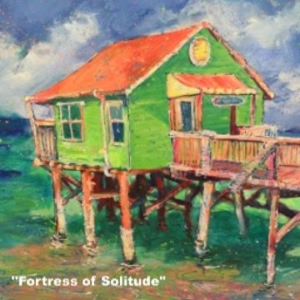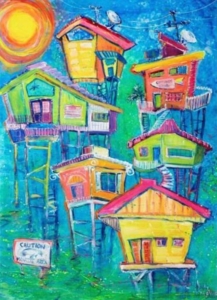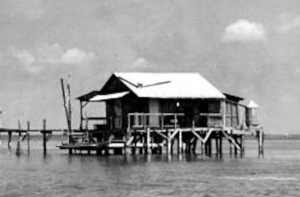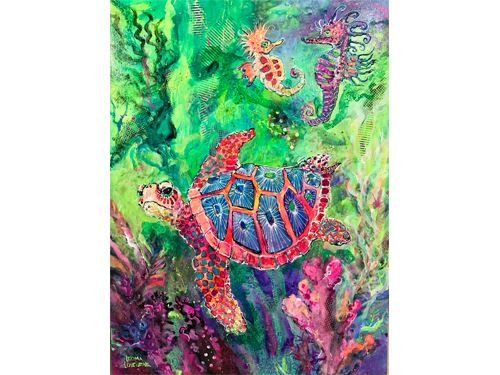 Here’s a painting I call Fortress of Solitude. Looks like a terrific place to get away from everything, don’t you think? It is inspired by the stilt fish houses that the Punta Gorda Fish Company built on pilings in the waters around Pine Island more than 100 years ago.
Here’s a painting I call Fortress of Solitude. Looks like a terrific place to get away from everything, don’t you think? It is inspired by the stilt fish houses that the Punta Gorda Fish Company built on pilings in the waters around Pine Island more than 100 years ago.
The earliest fish shacks were just icehouses where anglers could store their catches before delivering them to the processing plants located in and around Charlotte Harbor and half day sail to the north. Later, fishermen began living in them, storing ice and their catches underneath the enclosed residences on top.
 The living quarters they built were pretty rough. They definitely had none of the modern-day comforts we tend to take for granted today. They had no electricity or plumbing. Rain gutters collected the fresh water they used for drinking and cooking. The waters of the sound was where they cooled off and bathed. There was no such thing as insulation, so they filled their cypress and pine planked walls with sand and shells to provide protection from wind and storms.
The living quarters they built were pretty rough. They definitely had none of the modern-day comforts we tend to take for granted today. They had no electricity or plumbing. Rain gutters collected the fresh water they used for drinking and cooking. The waters of the sound was where they cooled off and bathed. There was no such thing as insulation, so they filled their cypress and pine planked walls with sand and shells to provide protection from wind and storms.
The occupants would fish for mullet and pompano at night, and mend their days by day. Sometimes they’d deliver their catches to the processing plants themselves. At other times, boats would come by to pick up their catches and deliver fresh ice, food and other provisions.
 Sturdily built, many survived storms and the elements for decades on end, but the State of Florida began burning them to the waterline in the 1980s when the Department of Natural Resources said they’d become unsanitary navigational hazards to the recreational fisherman who frequented our waters and used shacks as flop houses during rainstorms or time outs from fishing. Folks intervened before they were all gone. Today, only ten of the stilted fish camps remain in Southwest Florida. They’re all on the National Register of Historic Places.
Sturdily built, many survived storms and the elements for decades on end, but the State of Florida began burning them to the waterline in the 1980s when the Department of Natural Resources said they’d become unsanitary navigational hazards to the recreational fisherman who frequented our waters and used shacks as flop houses during rainstorms or time outs from fishing. Folks intervened before they were all gone. Today, only ten of the stilted fish camps remain in Southwest Florida. They’re all on the National Register of Historic Places.
When you think of storms like Donna and Charley, it’s truly remarkable that any are left!









